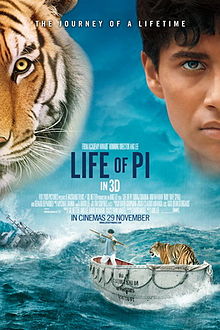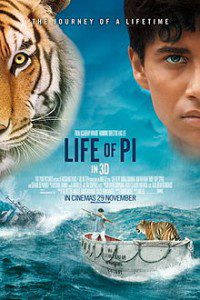
12 Jan TIO NYC: “LIFE OF PI” AND “FAKING IT” AT THE MET
 What to do on a rainy day in New York? Try fishing for your dinner.
What to do on a rainy day in New York? Try fishing for your dinner.
That’s what it felt like, like all we had to do was reach out and grab a fish right out of the ocean as it flowed into our laps from the ocean in one of many mesmerizing sequences in Ang Lee’s adaptation of Yann Martel’s Booker-winning bestseller, “The Life of Pi.” (2001).
The groundbreaking movie, which we watched in 3D – the only way to go – is a tour de force that pulls off the nearly impossible: Lee manages to combine nonpareil technical achievement with aesthetic beauty (according to our brother-in-law, a three times Oscar-nominated Hollywood film editor who knows from magic and eye appeal) and an emotional gut punch. Eat your heart out Jim Cameron and Peter Jackson.
Yes, we all became true believers, joining legions of goggle-eyed admirers of the film, once considered to be unfilmable for fairly obvious reasons.
For starters, Martel’s story takes place on a lifeboat in the middle of the Pacific Ocean and its shipwrecked hero, a young Indian boy named Piscine Molitor Patel — “Pi” for short — does not have another human soul to talk to for 227 days.
The larger hurdle was the cat.
In the book, Pi’s “co-star,” Richard Parker, is a full-grown 450-pound Bengal tiger – which Lee managed to fashion to startling perfection. His digitally created tiger is incredible, rather, very credible, a mash-up of pixels and real sinew ( based on a tiger named King). Altogether, Richard Parker becomes a tribute to William Blake:
Tyger! Tyger! burning bright
In the forests of the night,
What immortal hand or eye
Could frame thy fearful symmetry?*
Lee could
And as major fans of the director, we were not at all surprised.
Though Ang Lee is most recently associated with the 2005 Oscar-winning “Brokeback Mountain” (Best Director, Best Adapted Screenplay, and Best Original Score), a breakthrough film of a different sort, his “Crouching Tiger, Hidden Dragon,” 2000, (Best Foreign Language Film, Taiwan and six other Academy nominations including Best Picture) – remember the swordplay on the branches of swaying bamboo trees? – suggested Lee could be an apt effects man.
(Both films premiered at the Telluride Film Festival.)
The choice of 3D proved to be Lee’s masterstroke, turning this tale of magic realism into a pop-up storybook, “illustrated” by the luminous color-saturated cinematography of Claudio Miranda.
This tale of a teen and a tiger adrift on the ocean opens with opens with a gorgeous montage of birds and beasts, hummingbirds to zebras, linking India to Canada. That is followed by Pi (as an adult, Irrfan Khan) recounting his story to an inquisitive author with writer’s block (Rafe Spall.) He tells the man his tale might do more than unblock: it might convince the author (and audience) to believe in God.
The heart of the adventure begins when Pi (as played as a teenager by Suraj Sharma) travels with his family on a freighter bound for Canada, where his father hoped to reboot his business as a zookeeper. A storm wrecks the ship and the sixteen-year-old finds himself alone on a lifeboat with a hyena, a zebra, an orangutang and the aforementioned tabby. But the law of the jungle takes hold: the fittest quickly dispatches the other three. The existential ordeal for survival that follows is the crux of the transcendent fable.
Like the book, the movie leaves us in awe and wondering what exactly we saw and heard and was it true. But never for a moment do we doubt Lee’s expressive storytelling, his luxurious imagery and the sense of wonder they both arouse.
And all those wondrous special effects could arguably be traced back to the show we saw first at the Metropolitan Museum of Art: “Faking It-Manipulated Photography Before Photoshop.” Just connect the dots back to 1840s, the earliest days photography. Only the methods have changed.
It turns out that nearly every type of manipulation we now associate with digital photography was also part of the medium’s pre-digital repertoire: smoothing away wrinkles, slimming waistlines, adding people to a scene (or removing them), even fabricating events that never took place.
Room after room of images, some by brand names such as Edward Steichen and Jerry Uelsmann (whose work is carried by the Telluride Gallery of Fine Art) proves “the camera never lies.” People in dark rooms do.
*(“The Tyger,” from Blake’s “Songs of Experience.”)
For a preview, watch the official trailer of “The Life of Pi.”
Editor’s note: Just heard from a Hollywood insider, Lee’s next film will based on another bestseller, “Cleopatra,” by Stacy Schiff. The director is known for not repeating himself. Or his successes.



Sorry, the comment form is closed at this time.